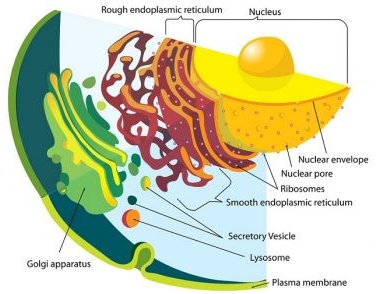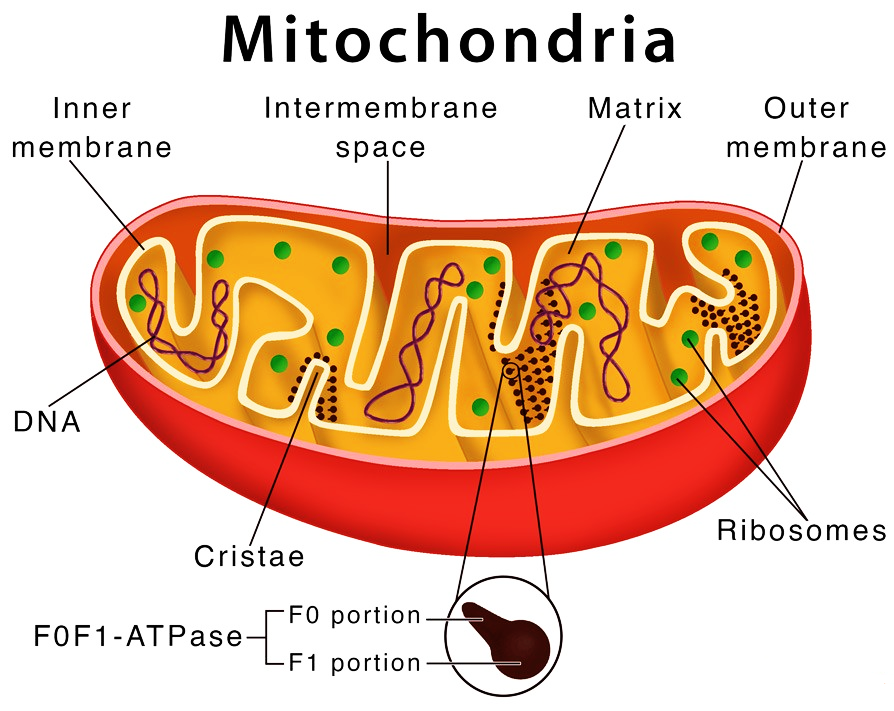
The Fundamental Unit of Life: Cell
Cell
➥The cell is known as the structural and fundamental unit of life because it is the basic building block of an organism and is capable of performing the basic functions of all living organisms.
Discovery of Cell
➥Robert Hooke (1665) Observed small honeycomb-like compartments in a piece of cork (dead part) using his self-made microscope. He called these compartments "cells."
➥He got that piece of cork from an Oak tree.
Discovery of Living Cell
➥Anton Van Leeuwenhoek (1674): Discovered living cells in pond water and observed bacteria.
Discovery of nucleus
➥Robert Brown (1831): Discovered the nucleus in plant cells.
Discovery of Protoplasm (Cytoplasm + Nucleoplasm)
➥J.E. Purkinje (1839): Discovered protoplasm (the living substance of the cell).
Shape of Cells
Cells come in various shapes:
- Circular: Example: Egg cell
- Filamentous/Spiral: Example: Muscle cell
- Tree-like/Branched: Example: Nerve cell
- Disc-shaped: Example: Blood cell
Size of Cells
- Smallest Cell: Bacterial cell (0.1 to 0.15 µm).
1meter(m) = 1000 millimeters(mm)
1 millimeter (mm) = 1000 micrometers (µm).
eg:Pleuropneumonia-like organism (PPLO - Bacteria), Mycoplasm (bacteria). - Largest Cell: Ostrich egg (170x135 mm² in diameter).
- Longest Cell: Nerve cell (up to several centimeters i.e., cm to m).
Number of Cells
- Unicellular: Organisms made up of a single cell, e.g., Amoeba, Yeast, Paramecium.
- Multicellular: Organisms made up of many cells, e.g., Humans, Animals.

Cell Theory
➥Cell theory was given by a Botanist Schleiden (1838) and a Zoologist Schwann (1839) :
- All living organisms are made up of cells.
- Cells are the basic units of structure and function.
- All cells arise from pre-existing cells (Rudolf Virchow, 1855, "Omnis cellula e cellula").
- Viruses are an exception to the cell theory.
Types of Cells (On the basis of Nucleus)
| Prokaryotes | Eukaryotes |
|---|---|
| Primitive nucleus (Nucleoid) | Advanced nucleus with nuclear membrane |
| No nuclear membrane | Nuclear membrane present |
| Small size (1-10 µm) | Larger size (6-100 µm) |
| Single circular DNA | Double helical DNA |
| Organelles not membrane-bound | Organelles are membrane-bound |


Difference Between Nucleus and Nucleoid:
| Feature | Nucleus | Nucleoid |
|---|---|---|
| Definition | Membrane-bound organelle in eukaryotes | Region without membrane in prokaryotes |
| Membrane | Double-layered nuclear membrane | No membrane |
| Organisms | Eukaryotes (plants, animals) | Prokaryotes (bacteria) |
| DNA | Linear chromosomes | Circular DNA |
| Additional Structures | Contains nucleolus | No additional structures |
| Cell Division | Mitosis and meiosis | Binary fission |
1. Plasma Membrane or Cell Membrane:
➥It is also known as a selectively permeable membrane because it permits the entry or exit of some substances in and out of the cell.
➥It is the outermost covering of the cell.
➥It is made up of proteins and lipids (lipids + Proteins = lipoprotein).
➥It helps in diffusion and osmosis.
Diffusion:
➥Movement of gases from a region of higher concentration to a region of lower concentration.
Osmosis:
➥Movement of water molecules from the region of higher concentration to the region of lower concentration through a semi-permeable membrane.
Types of Osmosis:
- Endosmosis: The process in which the water molecules/solvent enter into the cell. (Cell Swell)
- Exosmosis: The process in which the water molecules/solvent move out of the cell. (Cell Shrink)
Types of Solutions
Isotonic Solution
➥In an isotonic solution, the water concentration of external solutions is the same as inside the cell.
➥There is no net movement of water molecules, so there is no change in the shape of the cell.
Character of Plasma Membrane
➥The plasma membrane is flexible, allowing the cell to engulf food and other materials from the external environment.
➥Amoeba engulfs/captures food by phagocytosis.
Endocytosis
➥The process which enables the cell to engulf food and other materials from its environment due to the flexibility of the cell membrane is called endocytosis.
Difference Between Diffusion and Osmosis
| Diffusion | Osmosis |
|---|---|
| Movement of molecules from higher to lower concentration. | Movement of water molecules from higher to lower concentration through a semi-permeable membrane. |
| Can occur in liquids or gases. | Occurs only in an aqueous medium. |
| Semi-permeable membrane is not required. | Semi-permeable membrane is required. |
2. Cell Wall
➥It is only present in plant cells and is the outermost covering of the cell.
➥It is rigid and made up of cellulose in plants and chitin in fungi.
➥It provides strength to the cell.
Plasmolysis
➥When a living plant cell loses water through osmosis, there is a shrinkage or contraction of contents of the cell away from the cell wall, which is known as plasmolysis.
3. Nucleus
➥ The nuclear membrane is double-layered and contains pores for material exchange between the nucleus and cytoplasm.
➥ The nucleus contains chromosomes (DNA and proteins), visible during cell division, which carry genetic information in the form of DNA molecules.
➥ DNA (Deoxyribonucleic Acid) molecules contain the information essential for constructing and organizing cells. These molecules consist of genes, which regulate cell functions and inheritance, and are visible as chromatin material in non-dividing cells.
➥ Chromatin material, visible as an entangled mass of thread-like structures, undergoes organization into chromosomes during cell division.
➥ The nucleus plays a central role in cellular reproduction and development by directing chemical activities and determining cell maturity.
Functions of Nucleus
1) It is known as the control center or brain of the cell.
2) It plays an important role in cellular reproduction.
3) It determines heredity through genes.
4) The hereditary material DNA and genes are located here.
5) The nucleus is absent in matured mammalian RBCs and phloem sieve tubes.
6) Based on the nuclear membrane, cells are classified as:
- Eukaryotic cells: Have a nuclear membrane (true nucleus, e.g., animal & plant cells).
- Prokaryotes: Lack a nuclear membrane (nucleoid, e.g., Cyanobacteria).
4. Cytoplasm
➥ The cytoplasm is the fluid content enclosed by the cell membrane.
➥ It contains specialized organelles.
➥ Organelles perform specific functions and are enclosed by membranes.
5. Cell Organelles
➥ Eukaryotic cells contain various membrane-bound organelles that carry out different functions in the cell. These include:
- Nucleus
- Endoplasmic Reticulum
- Golgi Apparatus
- Lysosomes
Endoplasmic Reticulum (ER)
➥ The endoplasmic reticulum (ER) forms a network of membrane-bound tubes and sheets within the cell.
➥ It provides frramework to the cell.
➥Also provides transport channels.
Comparison of Rough Endoplasmic Reticulum (RER) and Smooth Endoplasmic Reticulum (SER)
| Feature | Rough Endoplasmic Reticulum (RER) | Smooth Endoplasmic Reticulum (SER) |
|---|---|---|
| Appearance | Rough due to ribosomes | Smooth appearance |
| Function | Site of protein synthesis | Facilitates lipid, enzyme, and hormone production |
| Protein Synthesis | Involved in protein synthesis | No protein synthesis |
| Lipid Production | No role in lipid production | Facilitates lipid synthesis |
| Enzyme and Hormone Production | No role in enzyme or hormone synthesis | Functions in enzyme and hormone production |
| Detoxification | No detoxification capability | Crucial in detoxification, especially in liver cells |
Golgi Apparatus
➥ Named after its discoverer, Camillo Golgi.
➥ Comprises a system of membrane-bound vesicles arranged roughly parallel to each other in stacks known as cisterns.
➥ Facilitates the packaging and transportation of proteins across the cytoplasm.
➥ Performs functions such as storage, modification, and packaging of products in vesicles.
➥ Plays a role in the formation of lysosomes.
Lysosomes
➥ Filled with digestive enzymes from the RER, acting as the cell's waste disposal system.
➥ Digest foreign material and worn-out organelles to maintain cell cleanliness.
➥ Break down complex substances into simpler ones using powerful enzymes.
➥ Termed "suicide bags" as they may burst during cellular disturbance, leading to self-digestion.
➥ Involved in breaking down all organic material, including bacteria and old organelles.
Mitochondria
➥ The cell's powerhouses, with two membranes: porous outer and folded inner.
➥ Inner folds (cristae) increase surface area for ATP generation, the cell's energy currency.
➥ Produce ATP(Adenosine triphosphate, also known as ATP, is a molecule that carries energy within cells), used for cellular activities and mechanical work.
➥ Possess their own DNA and ribosomes, enabling protein synthesis.
Plastids
➥ Plastids, exclusive to plant cells, exist in two varieties: chromoplasts and leucoplasts.
➥ Chromoplasts are colored plastids, commonly found in flowers.
➥ Chloroplasts, a type of chromoplast, contain chlorophyll and enable photosynthesis, which regulates atmospheric oxygen levels.
➥ Leucoplasts lack coloration and primarily function as storage sites for starch, oils, and protein granules.
Ribosomes
➥ Membrane-less cell organelles involved in protein synthesis.
➥ Present in both prokaryotic and eukaryotic cells.
Vacuoles
➥ Storage sacs in cells, small in animals and large in plants.
➥ Plant central vacuole occupies 50-90% of cell volume and is filled with cell sap.
➥ Functions include providing turgidity and rigidity to plant cells and storing essential substances like amino acids, sugars, proteins, and consumed food items in single-celled organisms.
➥ Specialized roles include expelling excess water and wastes from unicellular organisms.
Differences Between Plant and Animal Cells
➥ Difference between a plant cell and an animal cell:-
Cell Division
➥ The process through which new cells are formed in organisms.
➥ New cells are formed for growth, cell replacement, and reproduction.
➥ Two main types: mitosis and meiosis.
Review Questions
- What are the three main points of cell theory?
- How did the discoveries of Hooke and Leeuwenhoek contribute to cell biology?
- Describe the differences between prokaryotic and eukaryotic cells.
- List the functions of at least three cell organelles.
- How do plant and animal cells differ in structure?





















0 Comments